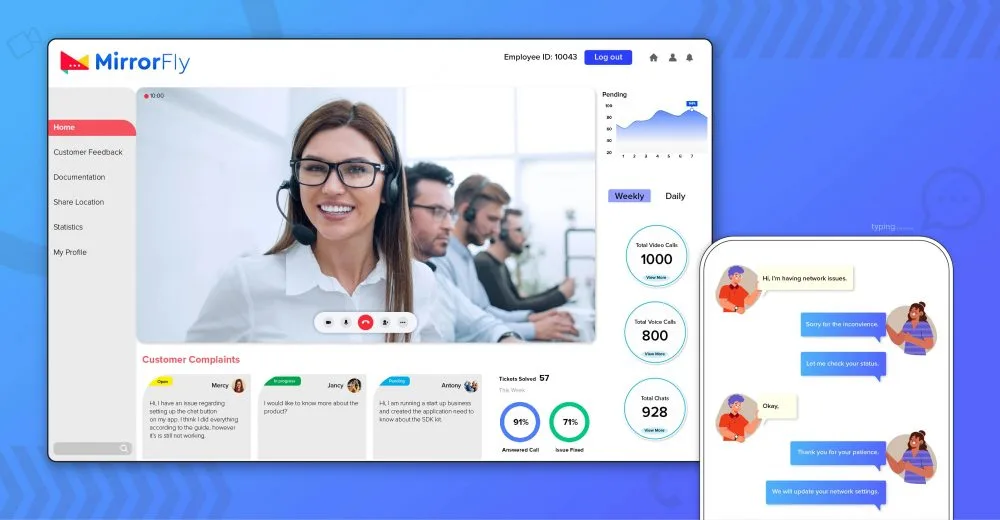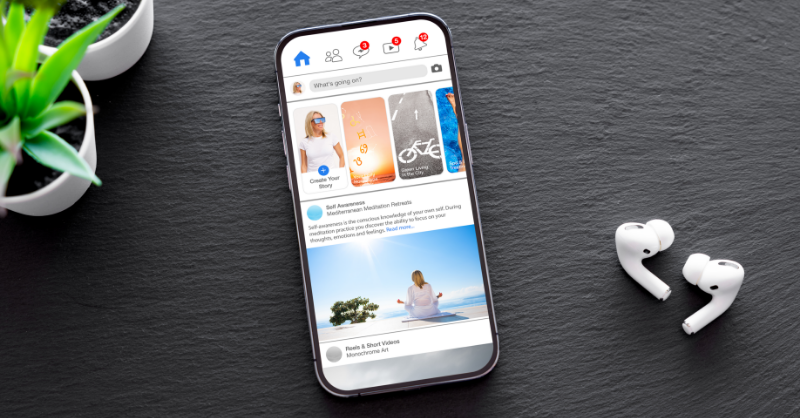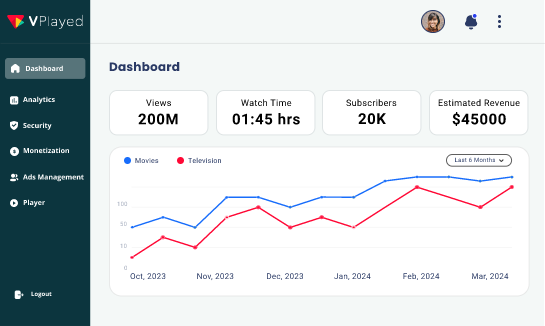The telecommunications industry has reached phenomenal heights in a short span of time. And they are the global leaders with the highest number of customers. Despite having the highest number of customers, it’s not quite easy to give proper customer support to everyone.
Telco customer service has a bad reputation among customers. The reasons are simple: higher waiting times, improper communication about the issues, no proper guidance to customers on fixing the issue, and continuous calls regarding the same issues. These things make your customers frustrated.
We understand your concern and will provide you with a solution. Live video support can solve problems on the first connection and increase customer satisfaction.
A recent survey about live video calls states that, “More than 90% of respondents say that live video calls make it easier to get their point across”.
Along with that, even businesses say that “98% of respondents state that video conferencing helps with relationship-building inside and outside the company”.
Table of Contents
5 Trends in Live Video Support
Video conferencing and chat tools aren’t new anyway; they have existed on the market for more than a decade.
In the mid-2000s, people shifted to video calling apps like Skype, Zoom, etc. in order to communicate with their distant friends, relatives, and colleagues from anywhere in the world.
Even some people tend to use it for business purposes and communication quite often. Then, by 2020, the pandemic situations had given a boon to the industry’s access from remote locations. The lockdown forced people to work remotely.
Businesses struggled to communicate in order to bring workflow and productivity back to normal. Live video, calls, and chat options helped a lot with communication and completing tasks. It was quite easy to monitor people anywhere around the world. A recent survey about video conferencing concluded that, “94% of businesses say video conferencing increases productivity.”
5 Benefits of APIs in the Telecom Industry

1. Clarity and Increased First-call Resolution
We all tend to use telco customer service numbers until we are quite familiar with them. Starting from the IVR and following up on each number until we reach the customer care executive could drain our patience by 50%, and the remaining 50% drains when the customer care executive tells you that they will forward your call to another department.
Then you tend to speak with another guy, tell him all your issues from the start, and he requests a call back! Done; the call ends. This is the most frustrating thing, isn’t it?
Even when he gives us a solution and hangs up, we try that solution, and it never works. Imagine that if a telco customer service agent is on a video call, face-to-face interaction increases the trust factor by diagnosing the issue and solving it in real time on the video call. Cool, isn’t it?
32% of customers will leave a brand after one bad experience. Give your customer care agent the tools he needs, like live video calls and chat options, and see how your customers are being satisfied on the first call.
2. Accessibility and Convenience
66% of the customers state that their number one complaint about telco customer services is waiting on hold to speak with a customer care agent.
You can sort out this issue simply by removing the need to call customer service and wait on hold. And add live video support.
Through live video support, customers can schedule their time, which avoids unnecessary waiting. At the scheduled time, both your customers and service agent can connect and resolve the issue in real-time without any waiting time.
Meanwhile, live video support gives you more convenience than on-site visits. When a customer schedules an on-site visit, you tend to offer them a window with a technician and also quite some waiting time. Get the process to a live video call, where everything happens in the same manner but remotely without waiting time.
3. Visual Empathy
Telco customer service agents are trained a lot in order to maintain patience with an abusive and arrogant caller by providing them with proper solutions.
Emotions are the most important part of human beings. No one’s going to yell unless there is a hard and frustrating issue.
If your customer care agents are solving the issue in a face-to-face call, that helps them understand the customer’s feelings by looking into their eyes and can help them act immediately.
From the customer’s point of view, it’s easy to be abusive on a faceless voice call, but it’s tough to be abusive face-to-face. So having live video support helps your company resolve problems both internally and externally as well.
4. Truck Roll Savings
A fully loaded truck with technicians on wheels for support, wandering the streets, fully fueled, maintenance, allowances—quite expensive, right?
Why go on a road to a solution at higher costs when you can do this simplified and with loads of savings?
Setting up with live video support can give you the freedom to reduce truck roll costs. Having scheduled appointments on live video calls makes your technicians work remotely even without stepping foot on the customer’s site.
Maybe it won’t help you shut down your truck rolls altogether, but it will help you reduce them step by step.
5. Increased Flexibility
Some telco company leaders say that having only live video support makes them lose out on other benefits. It’s time that we think about flexibility.
Okay, adding live video support doesn’t mean removing all your other supporting channels. It’s an add-on benefit or feature along with in-app chat, voice calls, and customer care services.
Live video support gives you the flexibility to solve issues in real-time quickly and clearly. Whereas adding live video support makes your customers think that you really care about them and their time.
Why Should Every Telecom Company Offer Live Video Support?
Whenever you make a survey about the satisfaction ratio of your customers with telco customer service, you know the results clearly.
Already, we have seen the statistics of customers leaving after one bad experience. If this issue continues, your bottom line will experience a great hit.
Offering live video support results in giving your customers increased resolution on their first call, at their convenience. And also gives your employees much-needed respect through visual empathy.
Most importantly, your bottom line can now find a way to save some expenses from your truck roll. Flexibility is a key that helps you find ways to have more satisfied customers.
Everything’s okay, but why MirrorFly?
We understand your concern, and the answer is quite simple.
Mirrorfly offers you the ability to easily integrate in-app video, voice, and chat APIs and SDKs.
And Mirrorfly also offers you business on your terms. It has two models of business: SaaS and SaaP (self-hosted).
SaaS: SaaS offers you a month-to-month subscription on your preferred budget.
Features
- Highly scalable
- Free chat SDKs
- 21-day free trial for voice and video calls
- Dedicated cloud server
SaaP: SaaP can be defined as “self-hosting, which simply means it’s all yours. With a one-time license fee, you will be permanently licensed for the in-app video, voice, and chat SDKs.
Features
- 100% customizable
- White-label solution
- On-premise hosting or cloud hosting
- Complete ownership
Moreover, MirrorFly’s in-app video APIs and SDKs are regulation- and compliance-compliant.
- HIPAA
- GDPR
- OWASP
Not only this, MirroFly’s in-app chat SDKs offer you 150+ enriched features, ultra-low latency support, a 99.999% uptime SLA, and a response time of <3 ms.
And with this, we can both come to a conclusion.
Conclusion
Now you have a handful of information and a clear mind. If you are still looking for any additional information about in-app chat, voice, and video APIs and SDKs, here’s something that could help.
Want to know more about the best in-app chat APIs and SDKs or need additional information on Mirrorfly’s in-app video, voice, and chat SDKs?
For easy integration of Mirrofly’s in-app video SDKs, click here.
Looking To Build Your Own Telecommunication App?
Get our enterprise-grade communication solution, that can be set up on your company servers.
Request Demo100% customizable
White-label solution
Full source code

Frequently Asked Questions (FAQ)
What are the two main types of telecommunication?
Telecommunications can be categorized into two major categories:
Wired communications
- Traditional telephone systems
- Ethernet
- Fibre optic communications
Wireless communications
- Mobile communication
- Wi-Fi
- Satellite communication
What is video telecommunications?
Video telecommunications involves real-time video functionality in telecom apps or websites. It includes one-on-one and group video calls, video conferencing, team collaboration, screen sharing, multi-party conferencing, webinars, etc.
How big is the global telecom API market?
The global telecom API market was worth $274.29 billion as of 2023. And it is expected to reach $529.29 billion by 2023. These values state the size of the global telecom API market. It includes messaging APIs, IVR/Voice Store or Voice Control APIs, WebRTC, and more.
Does telecommunications include video?
Yes, telecommunications includes video as one of its services. Telecommunication is the transmission of voice, data, and video to facilitate communication over long and short distances. The basic functionalities of telecom video include one-on-one and group video calling, live video calls, video conferencing, etc.








Leave a Reply